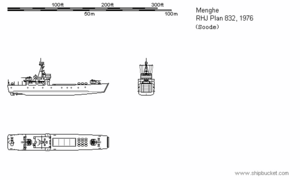Plan 832 landing ship
 3-view image of a Plan 832 landing ship
| |
| Class overview | |
|---|---|
| Name: | Plan 832 class |
| Builders: | Anchŏn Naval Yard |
| Operators: | Menghe |
| Preceded by: | none |
| In service: | 1975-present |
| Completed: | 17 |
| General characteristics Plan 832 | |
| Type: | Landing Ship, Medium |
| Displacement: |
|
| Length: |
|
| Beam: | 9.4 m |
| Draft: | 2.4 m |
| Propulsion: | 2-shaft marine diesel engine, 1200 shp total |
| Speed: | 12 knots |
| Range: | 700 nautical miles at 10 knots |
| Complement: | 52 |
| Armament: |
|
The Plan 832 landing craft (Menghean: 832設計中型上陸艦 / 832설계 중형 상륙함, pal-sam-i sŏlgye junghyŏng sangryukham) was a type of medium landing ship built in the Democratic People's Republic of Menghe during the 1970s. A total of 17 were completed. Today, these vessels are no longer in active service with the Menghean Navy, though some have been converted to missile reloading ships. In this role, they carry the designation Plan 1632.
Development
The Menghean Marine Infantry Force was established in 1966, under the jurisdiction of the Menghean Navy, two years after the end of the Menghean War of Liberation. Initially, its main operational mission was to conduct landings on the sides of the Altagracian peninsula in support of an effort to retake the territory from the mainland. Its secondary mission was to conduct counter-landings on any Menghean islands captured by hostile forces. Because all of their likely missions would be conducted across sheltered waters over ranges of under 50 kilometers, the Menghean Marine Infantry initially relied on small, open-topped landing craft, which could be mass produced at a low cost.
As the Menghean Navy grew, the naval leadership began expressing concerns that the Renkaku Islands represented a strategic danger to Menghe. The westernmost islands in the chain, 150 and 200 kilometers from Southwest Menghe, could be used as a staging point for an invasion, and aircraft and missiles based on the islands could intercept warships moving between the East Menghe Sea and the South Menghe Sea. In 1972, the DPRM established a new Independent Marine Brigade, based in Jindo prefecture in the southwest. While the brigade ostensibly intended for counter-landing operations in the southwestern islands, one of its battalions was tasked with seizing the westernmost island in the chain at the outset of the war, in order to deny its use to the enemy.
Originally, this battalion was matched with the same platoon-sized landing craft based around Altagracia. Given the longer voyage and rougher seas, however, Menghean commanders viewed these as inadequate. The Navy responded by submitting a design request for a mid-size landing ship with improved stability, range, and capacity, including the ability to transport heavy vehicles. Dayashinese reconnaissance aircraft photographed one of these ships at Gyŏngsan in 1975, and at least six separate hulls were identified by 1979.
Characteristics
The PLan 832 landing ship follows a simple design, with a blunt bow which can lower as a landing ramp. In many respects, it resembles a scaled-up personnel landing craft, but with better on-board support facilities, allowing it to carry troops more comfortably over a longer distance. The transport compartment is fully enclosed, providing protection from the weather, and bunk and head facilities are present. Even so, a range of 700 kilometers at 10 knots limits these ships to relatively short-distance landings.
The transport compartment is 46 meters long and 5 meters wide. Troops normally embark and disembark through the bow ramp, but supplies and vehicles can also be loaded through a large 13-by-5-meter roof hatch. Typical transport loads consist of
- one reinforced infantry company (~130 men), or
- five JCh-2 amphibious light tanks, or
- six BSCh-3 armored personnel cariers and their squads, or
- 200 tons of cargo.
Self-defense armament consists of two twin 50mm AA turrets. These are manually aimed and loaded but can be controlled by two fire directors on the superstructure. Some ships have been spotted with 12.7mm heavy machine guns on the bridge wings, but on others, the pintle mounts are left empty. No ships in the class have been spotted with multiple rocket launchers for land attack, a common feature on later Menghean tank landing ships.
Plan 1632 conversion
During the late 1990s, when relations with Dayashina improved and the Menghean Navy acquired newer amphibious warfare ships, many Plan 832 landing ships were removed from service. Of the decomissioned ships, six were rebuilt as missile loading ships (BT, Bojo Tanyaksŏn). This involved removing the forward 37.5mm AA gun and replacing it with a 5-ton crane which could be stored facing aft. The aft AA mount was also removed, though its mounting position was retained.
Designated Plan 1632, these ships were designed to anchor, dock, or moor alongside a friendly ship in port, then use the onboard crane to lift anti-ship missiles out of the large cargo hatch and into the alongside ship's launch boxes. Because this was a delicate operation, it could not be performed underway, but it did allow warships to re-load their missile boxes in small harbors and sheltered anchorages, far from major naval bases which could be targeted in an attack. Plan 1632 ships could carry a variety of anti-ship missiles, including the supersonic YDH-23, and could load missiles either by lifting them through the cargo hatch from above or by pulling them in on trailers through the open bow door. Because the bow ramp and internal cargo space were retained, Plan 1632 ships could also be used as amphibious or port-to-port transports, and in peacetime they were sometimes seen moving supplies between bases.